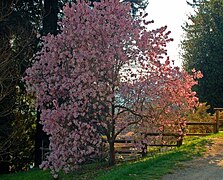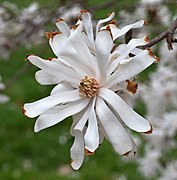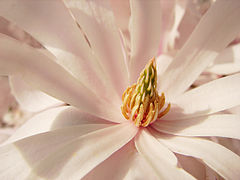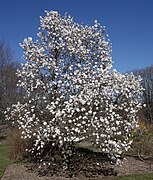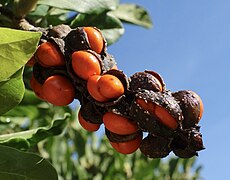| Magnolia stellata | |
|---|---|

| |
|
Scientific classification
| |
| Kingdom: | Plantae |
| Clade: | Tracheophytes |
| Clade: | Angiosperms |
| Clade: | Magnoliids |
| Order: | Magnoliales |
| Family: | Magnoliaceae |
| Genus: | Magnolia |
| Subgenus: | Magnolia subg. Yulania |
| Section: | Magnolia sect. Yulania |
| Subsection: | Magnolia subsect. Yulania |
| Species: | M. stellata
|
| Binomial name | |
| Magnolia stellata (Siebold & Zucc.) Maxim.
| |
Magnolia stellata, the star magnolia, [1] is a slow-growing deciduous shrub or small tree native to Japan. It bears large, showy white or pink flowers in early spring, before its leaves open. This species is closely related to the Kobushi magnolia ( Magnolia kobus), and is treated by many botanists as a variety or even a cultivar of that.[ citation needed] However, Magnolia stellata was accepted as a distinct species in the 1998 monograph by Hunt. [2]
Description

This shrub grows 1.5 to 2.5 metres (5 to 8 ft) [3] in height, spreading to 4.6 m (15 ft) in width at maturity. Young plants display upright oval growth, but the plants spread and mound with age. [4]
M. stellata blooms at a young age, with the slightly fragrant 7–10 cm (3–4 in) wide flowers covering the bare plant in late winter or early spring before the leaves appear. There is natural variation within the flower color, from white to rich pink; the pink also changes from year to year. The flowers are star-shaped, with at least 12 thin, delicate petal-like tepals, some cultivars having more than 30.
The leaves open bronze-green, turning to deep green as they mature, and yellow before dropping in autumn. They are oblong and about 10 cm (4 in) long by about 4 cm (1.6 in) wide.
M. stellata produces a reddish-green, knobby aggregate fruit about 5 cm (2 in) long that matures in early autumn. Mature fruit opens by slits to reveal orange-red seeds, but the fruits often drop before developing fully.[ citation needed]
Young twigs have smooth, shiny chestnut brown bark, while the main trunks have smooth, silvery gray bark. Like the saucer magnolia (Magnolia × soulangeana), it is deciduous, revealing a twiggy, naked frame in winter. Plants have thick, fleshy roots which are found fairly close to the surface and do not tolerate much disturbance.
Origins
The species Magnolia stellata may be found growing wild in certain parts of the Ise Bay area of central Honshū, Japan’s largest island, at elevations of 50 to 600 m (160 to 1,970 ft). It grows by streamsides and in moist, boggy areas with such other woody plants as Enkianthus cernuus, Corylopsis glabrescens var. gotoana and Berberis sieboldii. [5]
Hybrids
- Magnolia × loebneri = Magnolia kobus × Magnolia stellata.
This hybrid was first obtained by Max Loebner of Pillnitz, Germany. Paul M. Kache designated the new hybrid in 1920, to honour Max Löbner. Numerous other varieties are produced by these parents as 'Leonard Messel' and 'Merrill'. The selection, 'Leonard Messel' was a chance hybrid that was developed at Messel's garden in Sussex, UK, Nymans. Also on the market are white 'Ballerina' and the late-flowering white 'Merrill' that extend the loebneri season.
-
'Leonard Messel'
- Magnolia × proctoriana = Magnolia salicifolia × Magnolia stellata. The hybrid of these closely related species was first obtained in 1925 at the Arnold Arboretum of Harvard University.
- Magnolia liliiflora × Magnolia stellata, hybrid obtained at the U.S. National Arboretum by Francis DeVos and William Corsair. There are in the trade eight varieties with women's names, the "Eight Little Girls".
Cultivation
After it was introduced to the United States in 1862 by Dr. George Robert Hall (1820-1899), Magnolia stellata has been widely cultivated in much of North America, and has been recorded as an established escape in a few places. It is also a commonly grown ornamental in Europe, and was first introduced to the United Kingdom in 1877 or 1878, most likely by Charles Maries, while he was collecting for Veitch Nurseries.
Its compact size makes it an ideal subject for smaller gardens, where its flowers - appearing initially on bare stems - provide some much needed colour in early Spring. [6] The cultivars 'Centennial', [7] 'Jane Platt', [8] and 'Royal Star' [9] have all gained the Royal Horticultural Society's Award of Garden Merit.
Spring frosts can damage the flowers. The shrub prefers deep, acidic soil. It may be propagated by seed, or more easily by rooting cuttings taken after the flower buds have formed. [10]
Gallery
-
'Royal Star'
-
‘Centennial'
-
Immature fruit
-
Mature fruit with seeds
-
In autumn
References
- ^ "Magnolia stellata". RHS. Retrieved 23 February 2024.
- ^ Hunt, D. (ed). 1998. Magnolias and their allies. International Dendrology Society & Magnolia Society. ISBN 0-9517234-8-0
- ^ rhs 2013
- ^ Magnolia stellata Archived 2007-04-25 at the Wayback Machine
- ^ Royal Horticultural Society - Publications: The Garden March 2006 Archived 2008-10-03 at the Wayback Machine
- ^ RHS A-Z encyclopedia of garden plants. United Kingdom: Dorling Kindersley. 2008. p. 1136. ISBN 978-1405332965.
- ^ "Magnolia stellata 'Centennial' AGM". Royal Horticultural Society. 2017. Retrieved 2017-01-23.
- ^ "Magnolia stellata 'Jane Platt' AGM". Royal Horticultural Society. 2017. Retrieved 2017-01-23.
- ^ "Magnolia stellata 'Royal Star' AGM". Royal Horticultural Society. 2017. Retrieved 2017-01-23.
- ^ Floridata: Magnolia stellata


